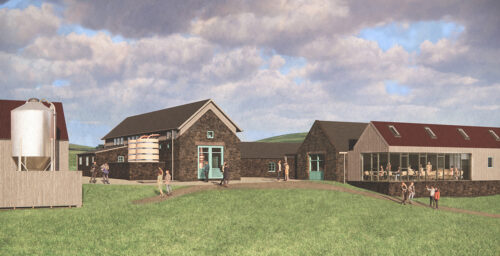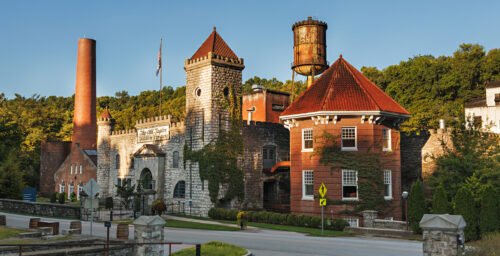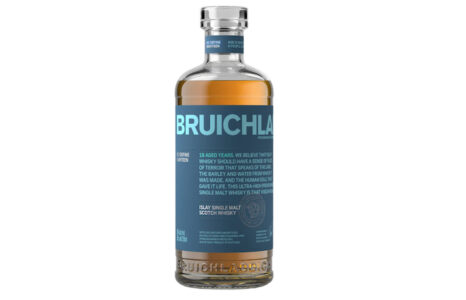Editor’s Note: The Whiskey Wash was recently invited on a press trip to visit Alberta Distillers. While all expenses were covered by the brand in question, full editorial control of this article remains with the publisher.
When one thinks of Canadian rye whisky brands produced, one which jumps most immediately to mind for many is giant Crown Royal. Another large player in the Canadian whisky world however is present also, and they are known as Alberta Distillers.
Alberta Distillers, owned by Beam Suntory, is based in Calgary, Alberta, and considered both the oldest distillery and largest distillery employer in western Canada. Its history starts back in 1946. Owned by Canadian philanthropists/oil tycoons, Frank McMahon and Max Bell, the two initially had what was said to be major problems distilling rye. They brought in George Reifel, a successful German Braumeister, who returned from many years distilling in Japan to fix their issues.
Starting as 23 acres on the outskirts of Calgary, it was, at the time, said to be the only distillery built to be solely ran on 100% rye. It saw some success and growth, and was eventually purchased in 1967 by National Distillers & Chemical Corporation, who added it to a portfolio that included Gilbey’s Gin and Peachtree Schnapps. Later sold again in the 1980s to American Brands because of Standard & Poor giving a negative economic outlook for whisky, its new owner, rebranded as Fortune Brands in 1997, morphed after a split in company divisions in 2011 to Beam Inc. This was followed just a few years later, in 2014, by the acquisition of Beam by Suntory.
[adsanity_group num_ads=”1″ align=”aligncenter” num_columns=”1″ group_ids=”49981″/]
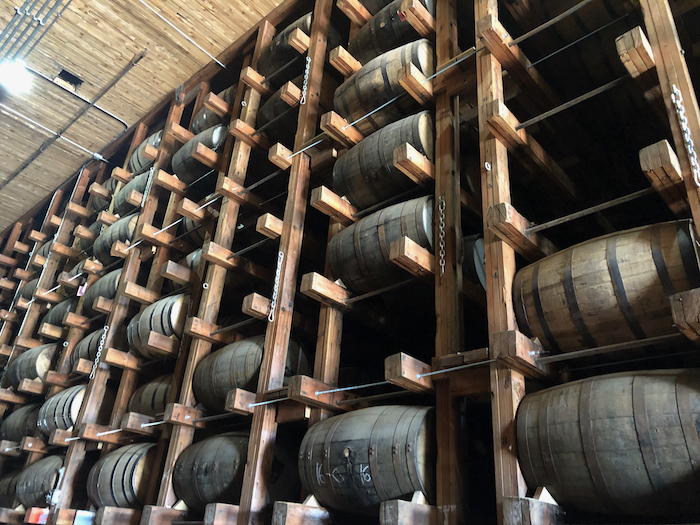
What is now Alberta Distillers today sits on some 41 acres of land and is considered to be in the heart of Calgary. It produces 21 million original liters of alcohol yearly across eight brands, aging over 450,000 barrels of whisky across 21 barrel warehouses. During a recent on site tour and subsequent presentation on their production process, the distillery team was quite forthcoming in their whisky making steps. As it is rare to have such detail, we’ve broken these out for you in their entirety below based on the information they provided us.
Preparation:
- Canada’s finest Prairie Grains are ground to a fine flour (meal) in a hammer mill on the main floor.
- ADL uses commercial enzymes when distilling corn but grows its own for rye, barley and wheat. These are grown in three enzyme reactors over a staggered 6-10 days to ensure ample fresh enzymes are available.
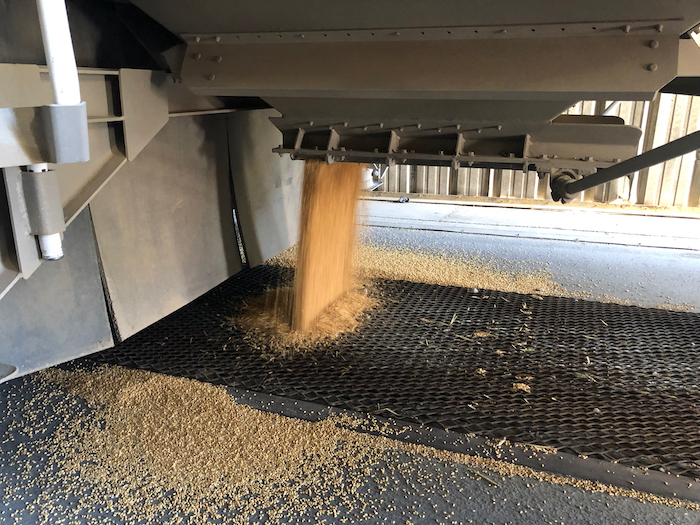
Mashing:
- 23,000 to 28,800 lbs. of meal is added to 27,000L of pure Canadian Rocky Mountain Water and heated to a cooking temperature that promotes enzymatic breakdown of starches into simple sugars. Each mash cycle is approximately 4 hours and Alberta Distillers has 3 mash cookers. The mash is cooled to fermentation temperature before it is transferred to a fermenter.
Fermentation:
- Cooled mash is transferred to one of 18 fermenters (6 open and 12 closed) that range in size (154,000 to 208,000 L).
- Simple sugars are converted to Ethanol, CO2 and Higher Alcohols by Yeast during a 72 to 96 hour fermentation.
- Heat generated by yeast activity is removed by an automated cooling system.
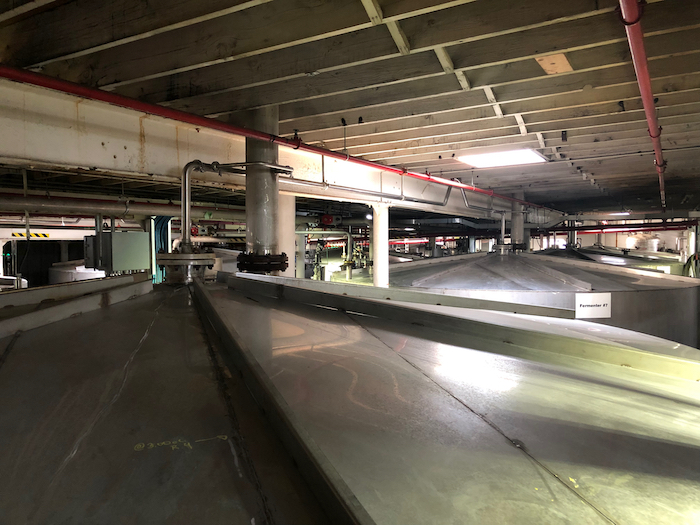
Distillation:
- High Wine is produced when Distiller’s Beer (fermentation product) is processed in the Beer Still.
- High Wine is further processed in a second distillation producing a final spirit (Canadian Whisky Spirit, Flavoring Spirit, Vodka, Gin …).
- The type of spirit depends on the distillation train, column temperature profile and addition of botanicals.
- The still types in use here:
- Beer Still: Column that converts Beer into High Wine
- Distiller’s Beer is converted into High Wine (65% ABV) and Stillage in a Sieve Tray Distillation Column. The 26 Tray Column is managed using column mid-point and top temperature.
- Continuous: Combination of an Extractive Distillation Column & a Rectifying Column that converts High Wine into a Neutral Grain Spirit
- Extractive Distillation Column: High Wine is stripped of higher alcohols (fusel oils) in a 42 Tray Extractive Distillation Column that uses dilution to adjust strength and change component volatility or boiling point.
- Rectifying Column: ED Bottoms Liquid is rectified in a 65 Tray Column that is comprised of both sieve and bubble cap trays. The alcohol strength is increased from 10 to 93-96 % ABV depending on final spirit.
- Batch: Combination of a Kettle (Pot Still) & Tray Column
- A Kettle (Pot Still) in-line with a 41 Tray Column that is comprised of bubble cap trays. The spirit profile is similar to that produced by the ED/RC distillation train. The Kettle is used separately to produce flavoring whiskies.
- Doubler/Kettle: Canada’s largest Pot Still (77,000 L). Used to make the finest Rye Flavoring Spirit. Formerly a copper pot still; currently a Stainless Steel pot still with sacrificial copper
- Beer Still: Column that converts Beer into High Wine
- The still types in use here:
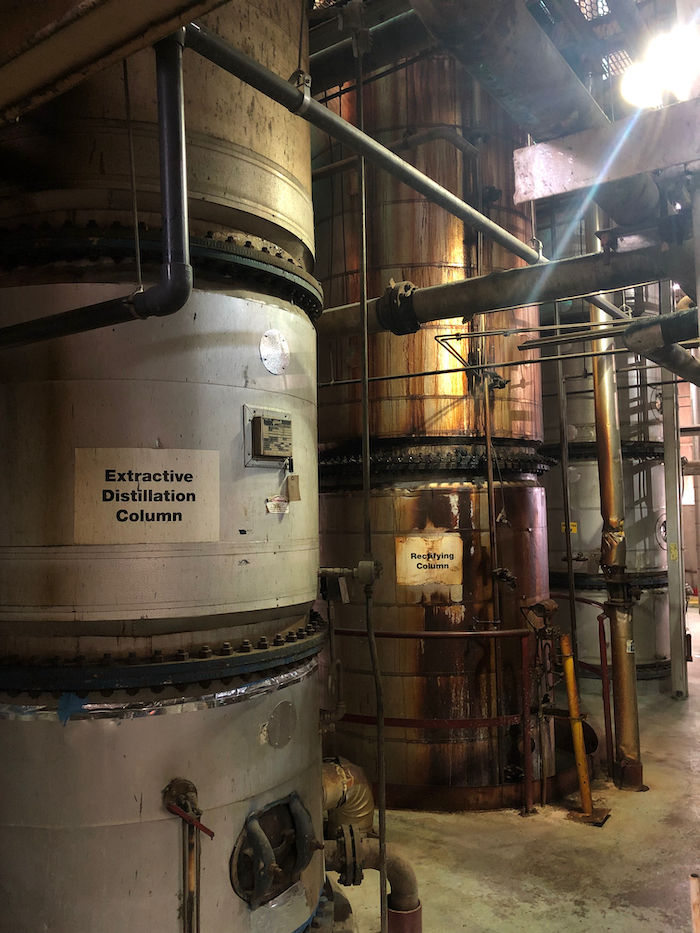
Barrelling:
- New charred white oak barrels, once used Bourbon barrels and re-used barrels are filled depending on spirit type.
- Each new fill is part of a designated bond that satisfies Canadian Excise Requirements.
- 400 – 600 barrels move through the hall on a daily basis.
- Spirit is aged for a minimum of 3 years before returning to the barreling hall for use in a blend.
- At the dump trough the bung is removed and a breather is inserted before the barrel is turned and the precious liquid is collected for a blend. ADL is the last Canadian distillery to dump barrels this way.
Warehousing:
- Spirit is aged for a minimum of 3 years in small wood in order to comply with Canadian Whisky Regulations.
- There are a total of 21 warehouses (10 pallet and 11 rack) on site containing a maximum of 500,000 barrels.
Laboratory:
- Spirit is analyzed at every step in the process to ensure a final product of the highest quality.
- Physical and sensory analysis is performed on every sample that enters the laboratory.
- Bond selection for blending sequences are determined by the laboratory.
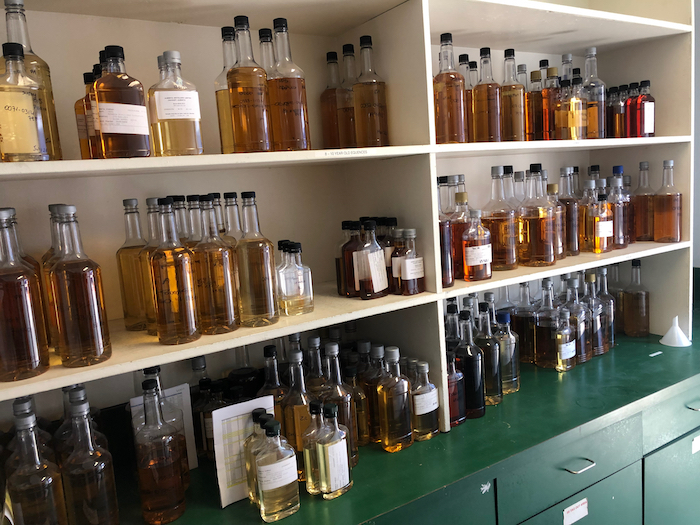
Blending:
- The place where the spirit becomes the final product bound for bottle (domestic) or container (international).
- Time honored traditions guide the blender in their creation of the perfect blend of the highest quality.
- 14 million liters of alcohol are processed annually by the department.
Packaging:
- All domestic packaging occurs on site for resale throughout Canada’s 10 provinces and 3 territories.
- 750,000 cases of award winning spirit are produced annually.
Shipping:
- 10.3 Million Liters of Alcohol shipped via rail car, sea container, tanker trucks and totes.
- In one year the distillery ships +200 Rail Cars, +150 Trucks and +85 Sea Containers.
- Bulk represents approximately 80% of the Alcohol leaving the facility to over 30 countries.
One thing that’s of particular note with regards to Alberta Distillers, I learned during my visit, is their commitment to use of local grains, often from the same farms year after year. Roughly 92% of the grain sourced last year came from Alberta alone. Also, besides the whisky, they produce several different vodkas.
For those in the United States wanting to try Alberta Distillers whisky, Alberta Premium is available for your consideration.

